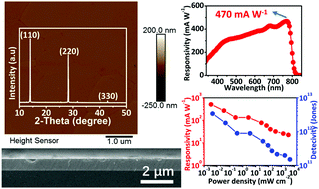Uniaxially oriented FAxMA1−xPbI3 films with low intragrain and structural defects for self-powered photodetectors†
Abstract
Metal halide perovskite films are promising candidates for applications in self-powered photodetectors owing to their astonishing photoelectric properties. Intragrain and structural defects present in the films can easily cause significant energy loss via carrier non-radiative recombination. Herein, a synergetic strategy of composition engineering and crystal engineering is developed for fabrication of (110)-uniaxially oriented FA0.2MA0.8PbI3 films on different substrates based on the pressure-induced fusion growth mechanism. The resulting composition-optimized films are composed of large grains with an average lateral size of 5 μm (on the SnO2 layer) and even 30.8 μm (directly on the Si substrate). Meanwhile, films with different thicknesses (0.2–1.5 μm) exhibit a single-crystal-like surface and single-crystal penetration across the film thickness, realizing lower trap densities, longer carrier lifetimes and excellent environmental stability. The corresponding perovskite self-powered photodetector presents a giant responsivity under white light (470 mA W−1 at 770 nm) and laser light (512 mA W−1, 671 nm) simultaneously. Moreover, the device exhibits markedly improved environmental stability, reproducibility, and a fast response.



 Please wait while we load your content...
Please wait while we load your content...